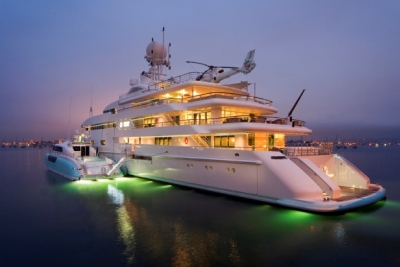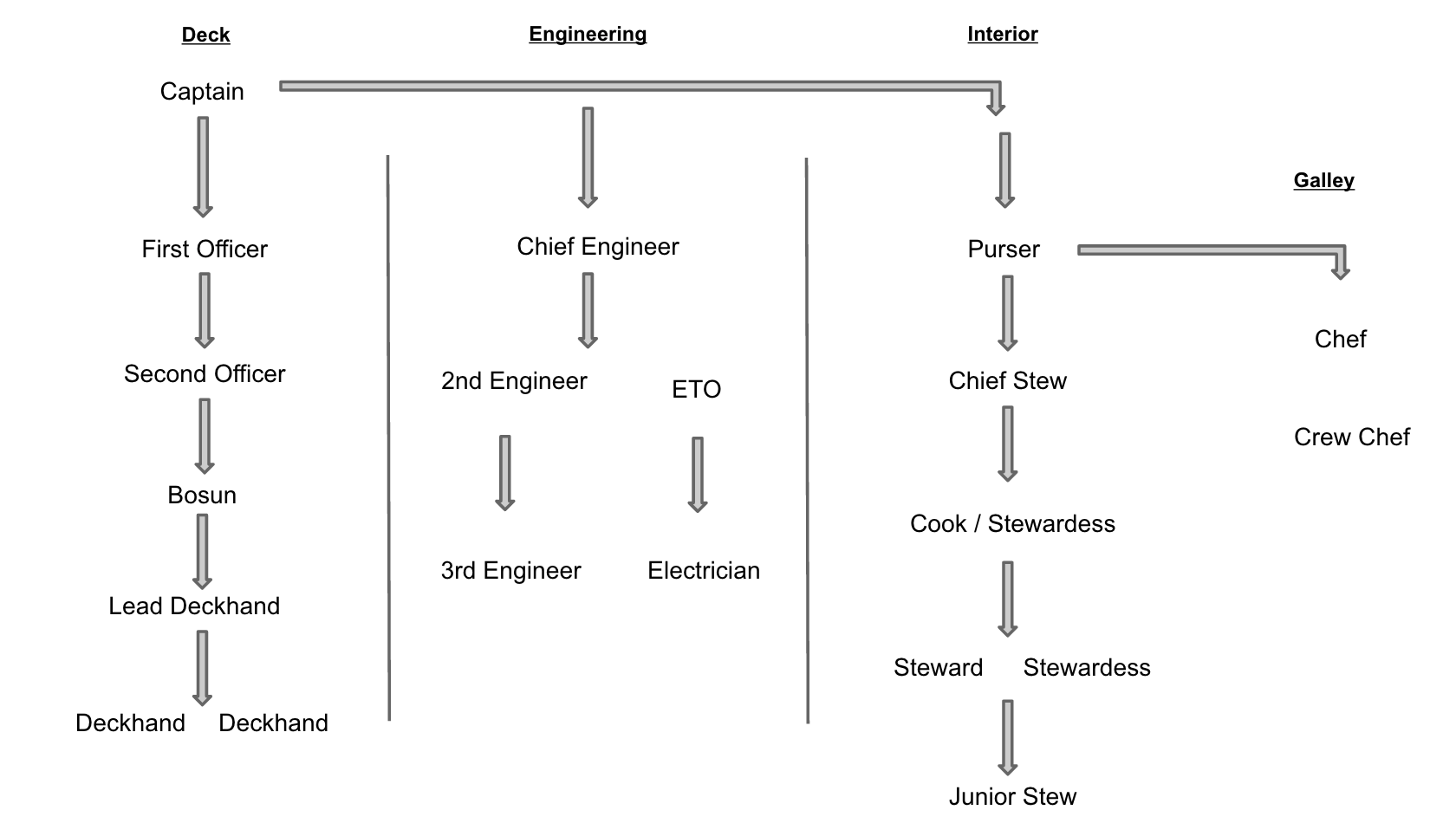
Yachting - Who's in Charge? Who do you report to?
Imagine building a multi-million dollar shiny floating toy and demanding that it remain dry, salt free and look brand new forever. Then imagine putting it in the ocean. Keeping a boat looking pristine and fully operational is no easy task.
You can compare the various roles onboard to the military... a very well spoken army of polite, highly trained and highly educated professionals, who work together to provide the highest levels of service known on earth. Bizarre as it may seem the goal of a successful crew is to provide the best possible experience to the guests onboard, the best maintenance, the best engineering the best water-sports fun ... the list goes on and on.
And yes... the guests onboard are likely to be gazzilionairs or famous or both, and they are used to the highest levels of service.
To keep the operation moving effectively and safely there are well defined hierarchies and reporting lines within the crew structure. Each department has is own internal hierarchy and career progression which match the required manning conditions (qualification required at each level) for a given size of boat. The bigger the boat the larger the hierarchy and the more qualifications are required at each level.
The successful operation of a vessel depends on its crew and each member of that team needs to be able to work well with the rest of the team, take on responsibility for the tasks that they are assigned and help other crew achieve their goals when necessary. A safe boat is one where each member of crew has a broad knowledge of the tasks and risks associated with all other roles onboard. It's no good only knowing how to perform a single function since in an emergency you may be required to step up to a new challenge, be a hero... save the day .. etc.
Here is an example hierarchy of positions onboard, use it as a guide to get the general idea of organisational structure. Every boat is different and the number of crew positions and lines of authority will differ.
Here is a brief description of the departments, roles and duties onboard a Superyacht.

Deck Department
Captain
The captain takes ultimate responsibility for the safe operation of the vessel and the welfare of the people onboard. The captain takes ultimate responsibility for the professional conduct of the crew.
First Officer / Chief Mate
The first officer is the captain’s second in command and manages the deck department. The first officer will regularly take bridge watches and may be responsible for the majority of the yacht’s navigation. On large vessels (+500 gross tons) the first officer may be required to ensure that the vessel complies with the International Safety Management (ISM) Code as well as the International Ship & Port Facility Security (ISPS) Code.
Second Officer
Larger yachts will often have a second officer in addition to the first officer. The second officer will share the bridge responsibilities of the first officer and will generally often be responsible for passage planning and chart corrections, as well as managing deck duties.
Bosun
The bosun is responsible for the exterior of the yacht and will oversee the deck team in its ongoing maintenance of the vessel. The bosun will often have additional deck maintenance skills including carpentry, basic engineering, varnishing and painting experience. They will co-ordinate the deck crew for close quarter manoeuvring and mooring or anchoring and manage the setup and operation of the yacht’s tenders and toys.
Lead Deckhand
The lead deckhand will assist the bosun with the more challenging deck duties during close quarter manoeuvring and mooring or anchoring. The lead deckhand will often be responsible for driving the tender and water-sports while guests are on board.
Deckhand
The deckhand will be involved in all ongoing deck cleaning and maintenance to ensure the yacht is immaculate at all times. Deckhands will often be required to stand watch, passerelle duty (in port security) and will be involved in all deck operations during anchoring and port manoeuvres.
Engineering Department
Chief Engineer
The chief engineer is responsible for the maintenance and proper functioning of all technical aspects of the yacht and its equipment, as well as managing the team of engineers to ensure everything on the yacht is fully operational at all times.
Second Engineer
The chief engineer’s second in command will be responsible for many of the repairs onboard.
Electrical Technical Officer (ETO)
The ETO is responsible for all the electrical equipment, lighting, electronic navigation systems, AV and IT systems on board. With guests demanding fast internet and multi-media systems the ETO plays a crucial role onboard interacting with both guests and the engineering department and will often report directly to the chief engineer or captain.
Electrician
The electrician will report to the chief engineer and will generally have experience with high voltage and generators and will concentrate solely on the electrical infrastructure of the yacht.
Third Engineer
The third engineer will generally perform all ongoing equipment maintenance tasks required onboard.
Interior Department
Purser
The purser is the yacht’s financial controller and will generally manage the accounts and provisioning onboard. The role of purser is often combined with the role of the chief steward(ess).
Chief Steward(ess)
The chief steward or stewardess is responsible for the interior upkeep of the the yacht as well as all guest service onboard. The chief steward(ess) will direct all guest hospitality and housekeeping and will be responsible for ensuring that the guests have everything that they need and are kept up-to-date with any necessary information. Additional medical and first aid training is a great advantage.
Steward(ess)
The Steward(ess) report to the chief steward(ess) and are on the front line of guest service and will tend to the comfort needs of the guests. Duties include serving drinks and food, looking after the housekeeping / laundry and making sure that the guests have everything they need at all times. An eye for design or flower arranging are useful skills.
Junior Steward(ess) / Laundry
Junior steward(ess) duties may include laundry, cleaning and assisting with housekeeping.
Cook / Steward(ess)
Steward(ess) roles may double as a cook onboard especially on smaller vessels. On larger boats they may assist the chef during busy periods or stand in for the crew chef.
Galley Department
Head Chef
Responsible for all the guests food and dietary requirements. The chef is responsible for creating meals of the highest quality.
Crew Chef
Reporting to the head chef the the crew chef may be required to help prepare guest meals. The crew chef is required to provide healthy meals for the crew on a daily basis. This is no mean feat as this can mean cooking for 20+ people three times a day as well as providing for different crew dietary requirements. The crew chef needs to keep the crew fed and healthy.
